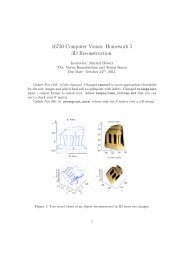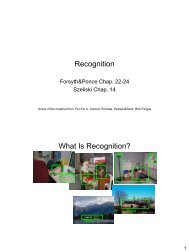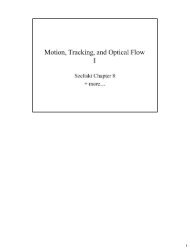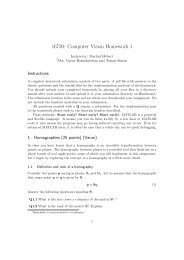16720: Computer Vision Homework 4
16720: Computer Vision Homework 4
16720: Computer Vision Homework 4
Create successful ePaper yourself
Turn your PDF publications into a flip-book with our unique Google optimized e-Paper software.
To make matching a bit more robust, we will implement a commonly heuristic: a<br />
descriptor i in D1 will be said to match j in D2 if the ratio of the distance to the closest<br />
descriptor (call it dist(i, j)) and second-closest descriptor in D2 (call it dist2(i, j)) is<br />
dist(i,j)<br />
smaller than α (i.e.,<br />
dist2(i,j)<br />
≤ α). A common value is α = 0.8. Note: Vedaldi provides<br />
a similar siftmatch function, you can use it to test but you are expected to implement<br />
your own.<br />
Q3.2 For the 6 test images (in images_test/), display the matches side by side<br />
with the training image (in objets/) with most matches, as below. (Use the function<br />
plotmatches(im1, im2, keypoints1, keypoints2, matches), where matches is 2 × N as<br />
above.). Save these images as q3_2_match#.jpg, substituting the testing image number.<br />
Figure 2: SIFT keypoint matches. Image: “Starry night”, from Van Gogh.<br />
4 Homographies, revisited.<br />
In homework 1, we used homographies to create panoramas given two images, but we had<br />
to (tediously) mark the corresponding points manually. Now, with SIFT and RANSAC<br />
in our bag of tricks, we can find these correspondences automatically. Our target application<br />
will be augmented reality—a fancy way of saying that we will embed synthetically<br />
generated elements from a virtual world into real-world images.<br />
The RANSAC algorithm can be applied quite generally to fit any model to data. We<br />
will implement it in particular for (planar) homographies between images:<br />
1. Select a random sample of 4 (tentative) correspondences from the total K (use the<br />
function randsample).<br />
2. Fit a homography to these. (A tentative model.) Use computeH_norm.<br />
3. Evaluate the model on all correspondences. All matches that the model fits with<br />
an error smaller than t make up the “consensus set”. Elements in this set are<br />
called inliers. To determine whether a match fits the model, evaluate the error in<br />
pixels of the projective relation: p 1 ≡ H 2→1 p 2 .<br />
4. If numInliers ≥ d, fit a homography to the consensus set.<br />
4







